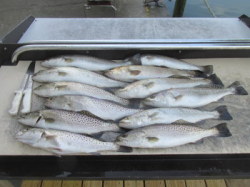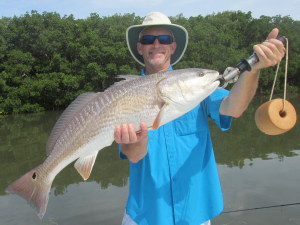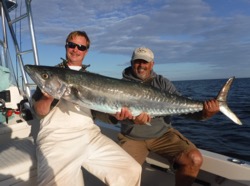What is the best day to fish in the next month? This is a question that all recreational anglers would love to have the answer to. Why? Because chances are, between family and work commitments, most recreational anglers are lucky if they can get on the water just once or twice a month. It sure would be nice to go on the days when catching fish was going to be the easiest. The good news is that “good” fishing days are somewhat predictable.

There are three or four key variables to the equation of determining a good fishing day. These are; the time of year (what fish should I target), tides, and weather (precipitation, temperature,wind direction and speed). So first, how does someone determine what to fish for. Well, nature decides that, for the most part. Fishing Guides in the Tampa / Clearwater Area are fortunate to have a wide range of species to fish for every year but it is certainly critical to know when each of these species will be available in large enough numbers to target. This information is readily available by contacting your local tackle store or favorite fishing guide. The internet can also give you this information although the first two sources are better as their information will be more accurate based on their understanding of current weather conditions and water temperatures.
Now that the target species is determined, what days will be best to catch this fish…or fish (plural) as several species may be available at the same time. Strong tides generally drive better fishing so a tide chart is the next thing to look at. Around the full and new (dark) moons, there are approximately 7 days that have stronger tides. Tides around the half moon are generally weak. What this means is that about half the days of every month are a lot better than the other half….so target a strong tide day. Tides are calculated by a mathematical algorithm so actual tide data is available well out into the future, so there’s no reason not to use this information. Another factor in determining when to fish for what is the actual volume of water movement. Generally speaking, there is more water movement during the middle of a tide phase than towards the top or bottom (high and low tides). Certain fish, like seatrout and snook, tend to bite best during maximum water movement.
Weather is a more complicated animal in determining when fishing will be productive. Weather includes precipitation, temperature, wind direction and speed. Precipitation doesn’t really complicate the decision making process. If’s there is a high percentage chance of rain and those going on the trip don’t want to get wet, don’t go. When inshore / nearshore fishing in the Tampa / Clearwater Area, rain, by itself, doesn’t really affect fishing much in a positive or negative way. If you add a high chance of lightening to the mix, and there’s plenty of it to contend with in this area, don’t go. A Tampa Fishing Guide’s first responsibility on all trips is not to catch fish, but to be safe…so most trips where lightening is a concern will be cancelled.

Temperature is the next variable. Fluctuations in temperature are not really a factor during the summer months. Water temperatures reach up into the 80’s, usually sometime in lat April to early May, and then stay there until the fall so monitoring the temperature is not really on the radar for most Tampa Fishing Guides during this time of year. Once cold fronts become a reality in late fall, early spring and winter however…temperature is very important. Shallow inshore waters are most impacted by temperature swings. An extremely cold night or two can plunge temperatures by ten degrees or more, which is devastating to the fishing. From a human perspective, it’s quite easy to understand. If a person is thrown into an icy lake, getting warm is the only immediate concern…not what’s for dinner. Depending on the severity of a cold front, fishing may be compromised anywhere from 2 – 4 days. Although fish will adjust and begin eating again at lower temperatures, it will still take several days for them to acclimate. Generally, several warmer days are required to get things back on track. In the winter, this is certainly true for seatrout fishing. Every fall, the first severe cold front can be significant as well. Each of the last two years, excellent kingfishing has been available within several miles of shore well into December. When the first severe front arrived however, it lowered ocean temperatures enough to drive these fish south towards their wintering grounds in the Keys. So, in this case, it removed a whole species from the target list for 3 – 4 months, until they return in the spring (as water temperatures rise).
Why is wind a significant factor? It can affect everything from where an angler can fish, to water clarity, to the level of the tide. Here are a few examples. A wind in excess of 15 miles per hour is sure to muddy inshore waters if it originates from the west, north or south. Why? A north or south wind blows right up or down through St Joseph’s Sound (The Inter-Coastal Waterway) guaranteeing that water will be muddy. A strong west wind will also affect the Inter-Coastal Waterway as, when the tide comes in, it brings in all of the churned up sand on the beaches. As all Tampa Fishing Guides know, seatrout and snook tend to eat better in clean water so, when the water is muddy, it might be better to focus on redfish…a fish less affected by water clarity. On a west wind however, a mid afternoon outgoing tide may provide both warmer and cleaner water so, on some cooler days, trout will eat on this tide where they would not eat on the morning incoming tide. Also, on a west wind, muddy water will extend out off the beaches, possibly creating low clarity all the way out to 5 or 10 miles. If it’s kingfish season, that’s important as kingfish will swim straight west into this wind until they get to clean water. If the angler is in a smaller boat and running 10 miles out is not a good option, then kingfish are off the list for that day. Obviously if winds are strong from any direction but out of the east, venturing offshore is not a good idea simply because of rough seas. On strong east winds, caution is still required as heading off shore (downwind) will seem easy but heading back into this wind will be much more difficult.
 Another reason to consider wind direction is when planning on where to fish. On a strong west wind, fishing outside off the beach is not advisable and fishing the eastern shore of the Inter-Coastal Waterway may not be either. Getting on the leeward side (east) of the larger barrier islands…Caledesi and Honeymoon…however, may be a great solution as this shoreline on these islands will be protected and, if the wind is west or southwest (even better), the wind will make the high tide higher and allow a longer time to catch redfish in the shallows…which is again a fish that will bite in wind-blown muddy water. Reciprocally, a northeast wind will lessen the tide height. This might affect certain shallower fishing spots, rendering them unfishable, as not enough water has come in to allow fish to get there. More importantly, if a boat is up in a canal and needs enough water to cross a shallow flat to go fishing, a northeast wind may make this flat uncrossable until several hours later than it would normally be…impacting the departure time of the fishing trip.
Another reason to consider wind direction is when planning on where to fish. On a strong west wind, fishing outside off the beach is not advisable and fishing the eastern shore of the Inter-Coastal Waterway may not be either. Getting on the leeward side (east) of the larger barrier islands…Caledesi and Honeymoon…however, may be a great solution as this shoreline on these islands will be protected and, if the wind is west or southwest (even better), the wind will make the high tide higher and allow a longer time to catch redfish in the shallows…which is again a fish that will bite in wind-blown muddy water. Reciprocally, a northeast wind will lessen the tide height. This might affect certain shallower fishing spots, rendering them unfishable, as not enough water has come in to allow fish to get there. More importantly, if a boat is up in a canal and needs enough water to cross a shallow flat to go fishing, a northeast wind may make this flat uncrossable until several hours later than it would normally be…impacting the departure time of the fishing trip.
So, several days before the next Tampa Fishing Trip, a local angler should check all of these variables to make sure fishing on the planned day is still viable . Assuming that the answer is yes, an itinerary should be created the night before as to what locations will be fished, based on weather and tides. As in any other endeavor, a little planning can result in a much more productive day.
